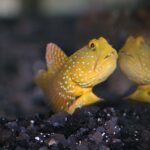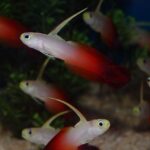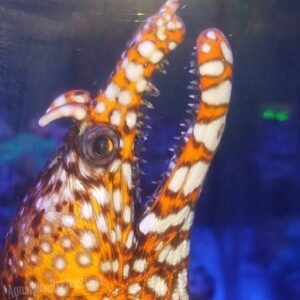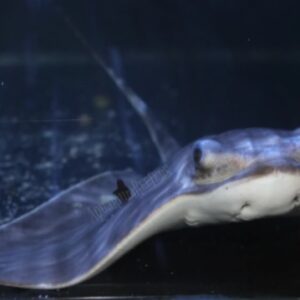Description
The Hi-Fin Banded Goby, scientifically known as Stonogobiops xanthorhinicus, is a small and colourful fish that can reach a maximum size of about 3 inches (7.6 cm). It has a slender body with a high dorsal fin, which gives it its characteristic “hi-fin” appearance. The body is adorned with beautiful bands of red and white, creating a striking and eye-catching pattern. They also have adorable yellow faces.
Natural Habitat:
The Hi-Fin Banded Goby is typically found in shallow reef environments, specifically in areas with sandy or rubble substrate. It often inhabits the crevices and burrows among the rocks or coral heads. These habitats provide the goby with protection and shelter.
Keeping the Hi-Fin Banded Goby Healthy:
The Hi-Fin Banded Goby requires a moderate level of care and attention. It is important to maintain stable water conditions with proper filtration and regular water changes. The temperature should be kept between 75-82°F (24-28°C), and the pH should range from 8.1 to 8.4. This species is delicate, so it is crucial to acclimate it carefully to its new environment.
Special Requirements and Feeding:
The Hi-Fin Banded Goby has a unique feeding behaviour as it forms a symbiotic relationship with pistol shrimp. They share a burrow, where the shrimp constructs and maintains the burrow, while the goby acts as a lookout for potential threats. In terms of feeding, the Hi-Fin Banded Goby is primarily a carnivorous fish. It feeds on small invertebrates, including copepods, amphipods, and other small crustaceans. It is beneficial to provide a varied diet that includes frozen and live foods such as brine shrimp and mysis shrimp.
How Many Should I Keep:
Hi-Fin Banded Gobies can be kept individually or in pairs. If keeping multiple gobies, ensure that there is enough space and hiding spots for each fish to establish their territories.
Lighting Preference:
The Hi-Fin Banded Goby does well under moderate to high lighting conditions. It adds a vibrant and colourful presence to a well-lit aquarium.
Suitable Tank Mates:
The Hi-Fin Banded Goby is generally peaceful and can coexist with a variety of tank mates. Compatible tank mates include other small, non-aggressive fish and peaceful invertebrates such as corals, shrimp, and small snails. Avoid keeping them with larger, aggressive fish that may pose a threat to the goby.
Symbiotic Relationship with Pistol Shrimp:
The Hi-Fin Banded Goby, Stonogobiops xanthorhinicus, forms a fascinating symbiotic relationship with certain species of pistol shrimp. The goby and shrimp share a burrow, where the shrimp constructs and maintains the burrow, while the goby acts as a lookout for potential threats. This partnership provides mutual benefits, with the shrimp gaining protection and the goby finding a safe refuge.
Reproduction in the Wild:
In the wild, the Hi-Fin Banded Goby reproduces through a process known as broadcast spawning. During this reproductive event, male and female gobies release their gametes into the water column simultaneously, allowing for external fertilization to occur. The fertilized eggs then develop into planktonic larvae, which eventually settle onto the substrate and undergo metamorphosis into juvenile gobies.
Breeding Stonogobiops xanthorhinicus:
- Set up:
To breed Hi-Fin Banded Gobies in captivity, a separate breeding tank should be set up. The tank should have suitable hiding spots, such as small caves or PVC pipes, where the gobies can lay their eggs.
- Courtship/Spawning:
The courtship behaviour of Hi-Fin Banded Gobies involves intricate dances and displays by both the male and female. Once the female is ready to lay eggs, the male will entice her to a chosen spawning site. The female will then deposit adhesive eggs on the substrate, which the male simultaneously fertilizes.
- Rearing:
After spawning, it is recommended to transfer the eggs to a separate rearing tank to protect them from potential predation. The eggs typically hatch within a week, and the larvae will require specialized foods, such as rotifers and newly hatched brine shrimp, for proper growth and development. As the juveniles mature, they can be gradually introduced to a regular diet of copepods and other small foods.
Sexual Dimorphism:
Hi-Fin Banded Gobies do not exhibit significant sexual dimorphism, meaning it is challenging to visually distinguish between males and females based on their external appearance alone. Further examination or microscopic analysis may be necessary to determine the sex of these gobies.
Distribution:
The Hi-Fin Banded Goby, Stonogobiops xanthorhinicus, is typically sourced from the Western Pacific region, including areas such as Indonesia, the Philippines, and the Maldives. While captive-bred and line-bred strains are available in the aquarium trade, the original wild fish are native to these regions.
Summary:
The Hi-Fin Banded Goby, Stonogobiops xanthorhinicus, is a captivating fish with its unique hi-fin appearance and vibrant colouration. It forms a beneficial symbiotic relationship with pistol shrimp, adding an interesting dynamic to the aquarium. Reproduction occurs through broadcast spawning in the wild, and breeding in captivity involves careful setup, courtship behaviours, and rearing of the larvae. While not displaying prominent sexual dimorphism, these gobies originate from the Western Pacific region and are a stunning addition to marine aquariums.
The Fish pictured here are representative only and the livestock you receive may vary in pattern, coloration, and shape.








